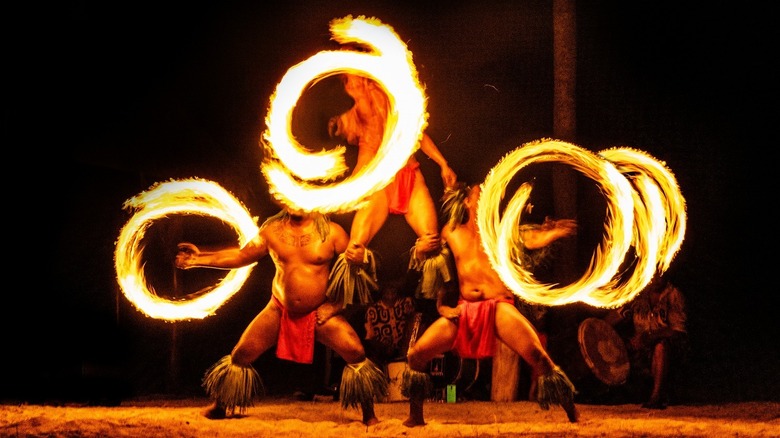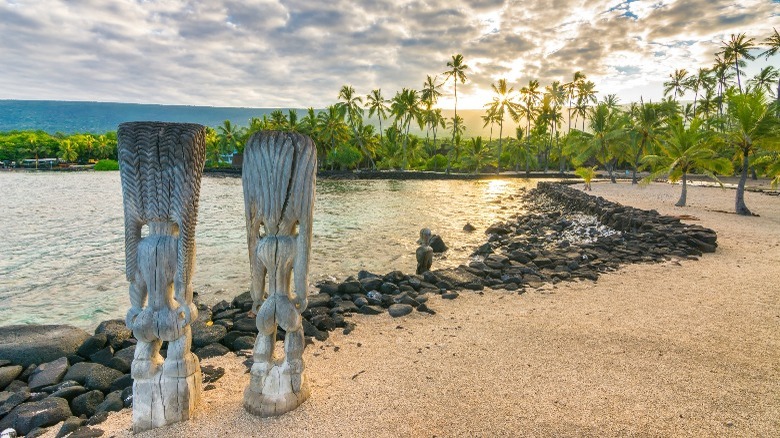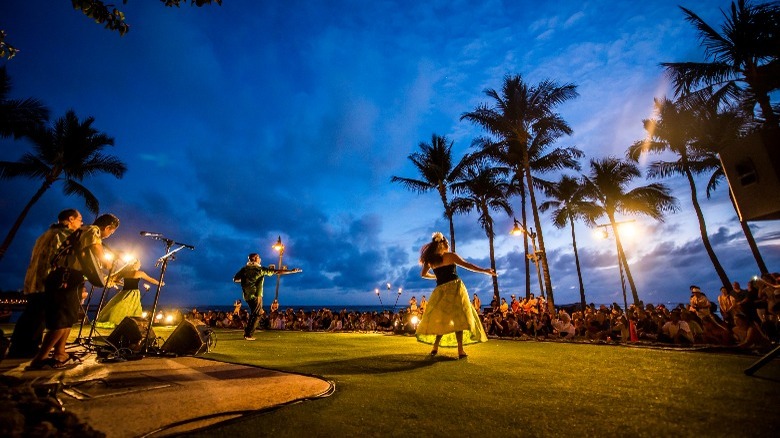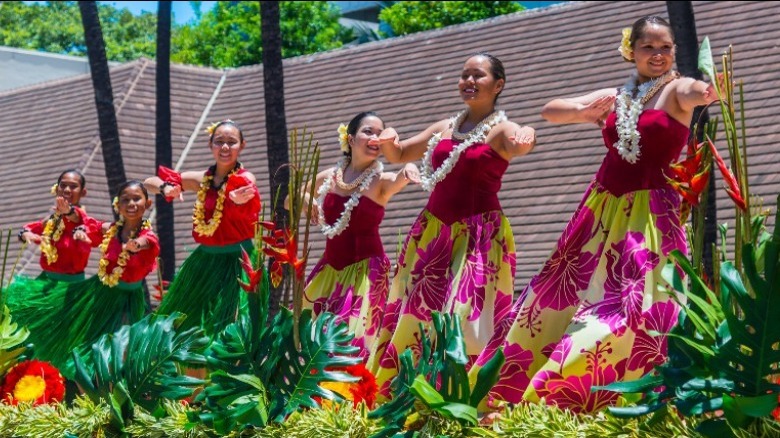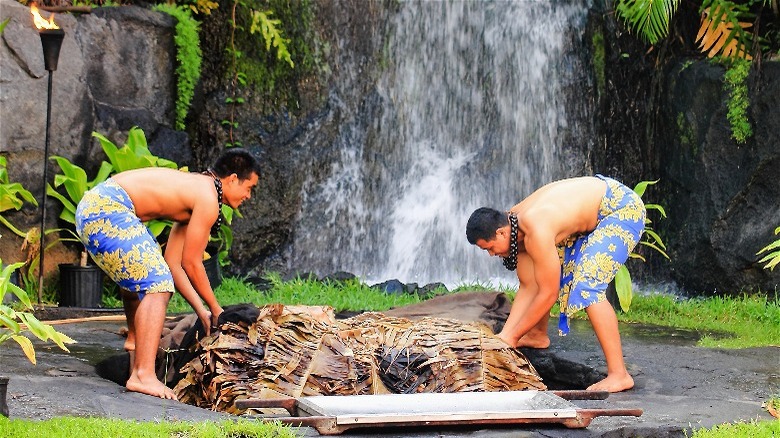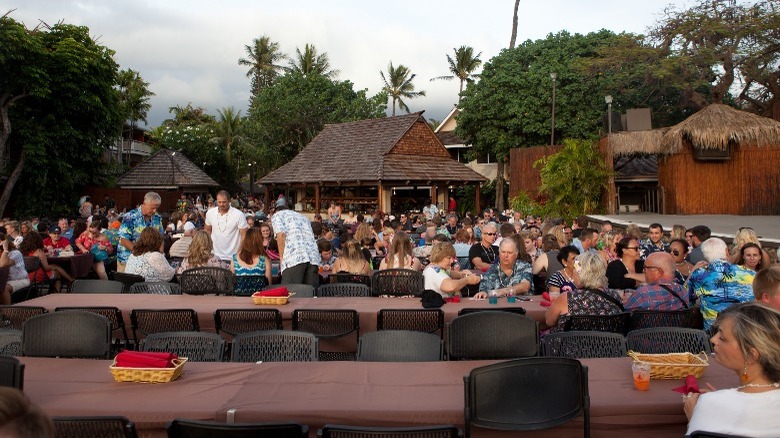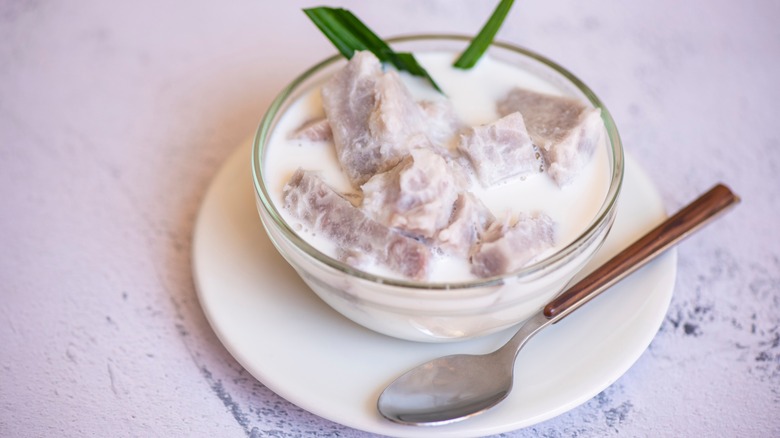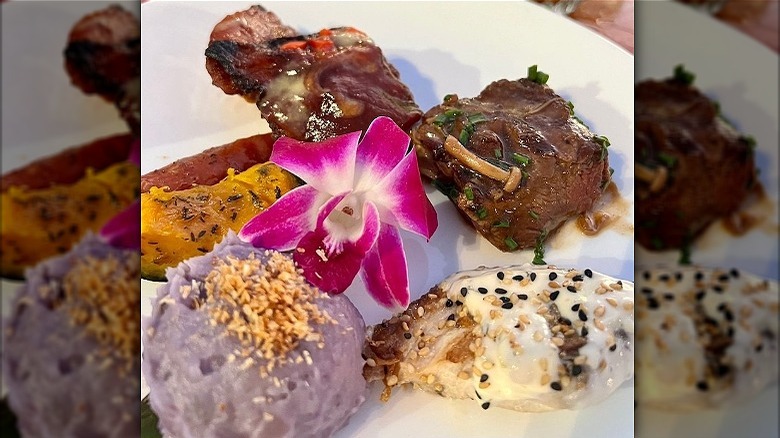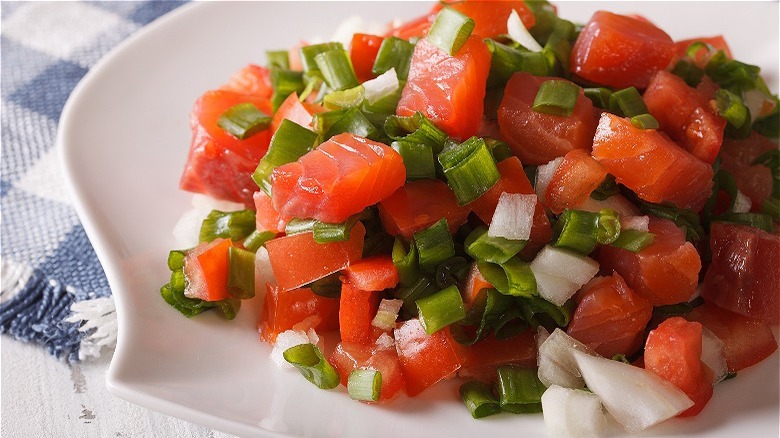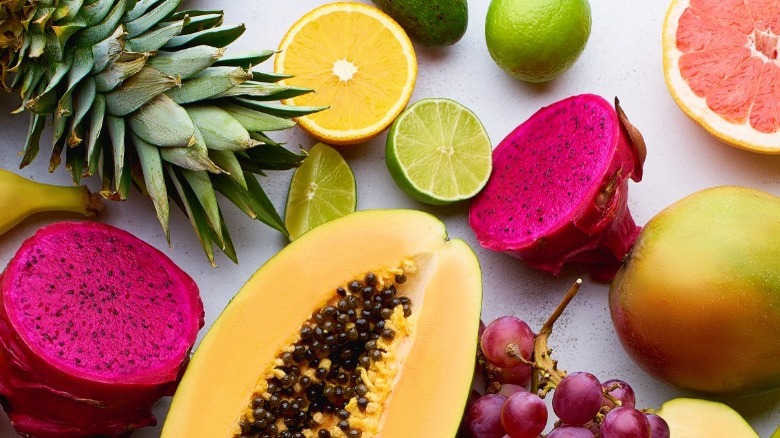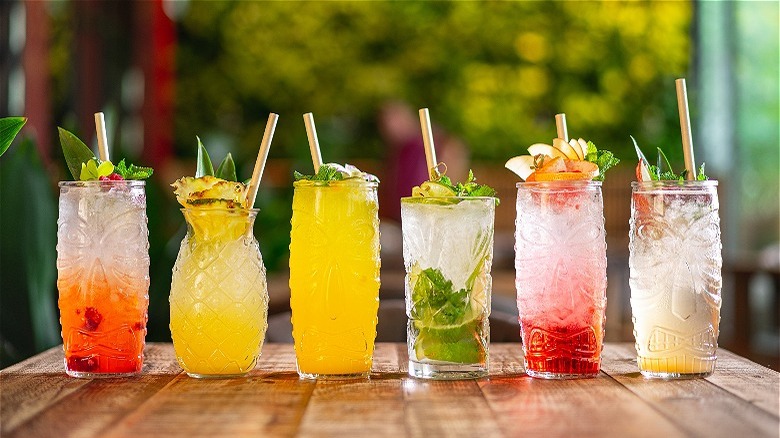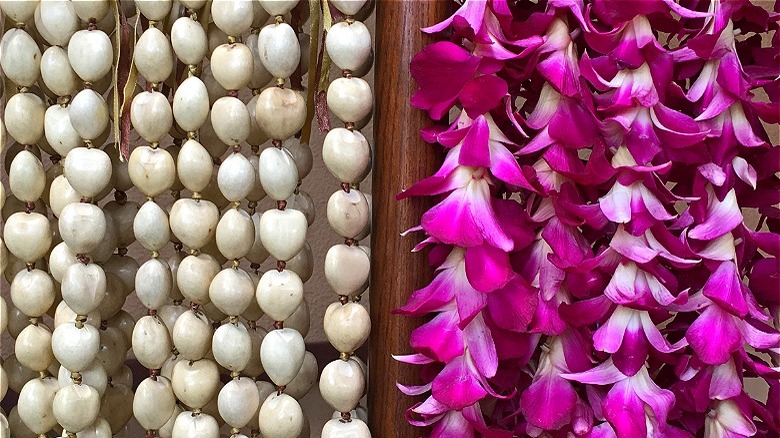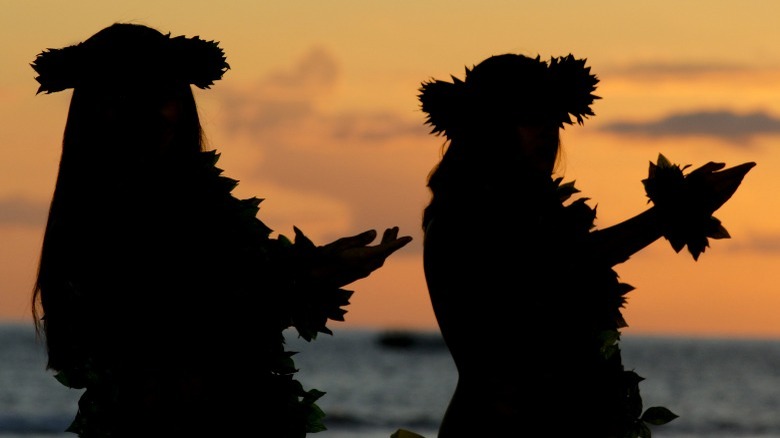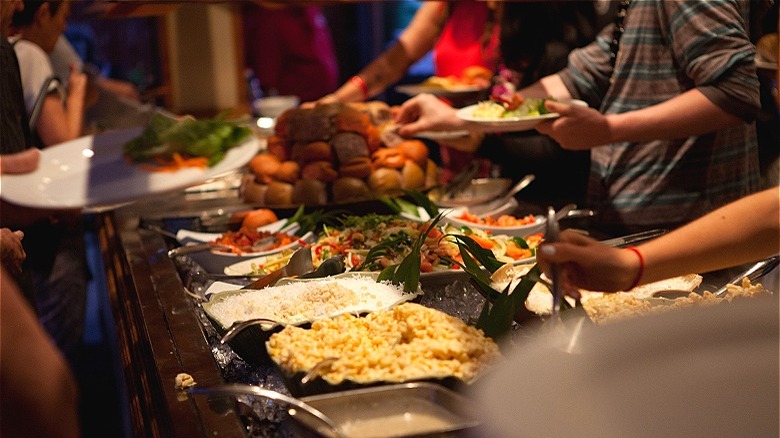What A Hawaiian Luau Is Really Like
A luau is more than just a theme for a backyard barbecue or class party. For Hawaiians, it's a way of celebrating important milestones such as birthdays, weddings, and graduations (via Hawaii Luaus). But for visitors, going to a luau on one of the islands is a popular tourist attraction that's viewed as a way for outsiders to experience Hawaiian and Polynesian traditions firsthand. Today, it may not be the most authentic way to learn about these cultures, but luaus do have their roots in ancient customs. You can see traces of those traditions even when you pay an entrance fee to attend a Hawaiian luau.
You can expect a number of constants at every luau. A feast, entertainment, tropical drinks, an imu, and some lei necklaces will all likely be included at the long event. At the very least, luau guests get to sample classic Hawaiian foods like poi, poke, and kalua pork, all served as part of a generous food buffet. Read on to find out how the luau has evolved from a historic and traditional celebration to a tourist attraction.
The event as we know it began in the 1800s
Hawaiian luaus and similar events similar took place long before tourists from the mainland were invited. After all, the Polynesian people arrived on the Hawaiian islands around 400 C.E., according to Smithsonian Magazine. It's no surprise then, that Hawaiian feasting celebrations known as aha'aina existed long before luaus. As Maui Luau explains, the word aha'aina refers to a gathering meal. Food and entertainment were still important to these events, but the execution of traditional ceremonies was the focus. An aha'aina could be held to commemorate special occasions, such as revering the Hawaiian gods, acknowledging a battle, or even premiering a new canoe. Men and women sat separately at these events, as the two groups were forbidden from eating together.
This all began to change in the early 1800s. In 1819, King Kamehameha II changed Hawaiian traditions forever. According to Hawaii Luaus, the king held events where he would eat with women, effectively breaking the rule that dictated genders had to dine separately. Kamehameha's feasts eventually laid the groundwork for the modern-day luau.
In the second half of the 19th century, Victorian visitors began participating in luaus. The events were multisensory affairs, and per Hawaii Luaus, one luau guest in 1883 commented that the aromas from the floral leis and maile leaves was strong and heady.
Tourist participation began to grow in the following century
According to Frommer's, Hawaiian tourism began around the 1860s, when a visitor center for the Kilauea Volcano was built. Then, in 1901, the Moana Hotel opened on Waikiki Beach in the city of Honolulu on the island of Oahu. Vacationing in Hawaii started to be pursued by tourists (usually from San Francisco), who traveled to Honolulu by boat. By the 1920s and 1930s, Hawaiian tourism was reaching a peak, explains Travel Pulse.
Nonetheless, it would take decades for luaus to become popular with vacationers. Trafalgar notes that as Hawaiian culture became known, more and more tourists began to seek out luaus as an attraction. In fact, Hawaiian culture was quickly becoming an interesting aesthetic to Americans in the '60s, in part due to representations in media and restaurant culture (via HuffPost). In 1961, Elvis Presley starred in the popular film "Blue Hawaii," and the following year The Beach Boys released their album "Surfin' Safari," propelling interest in surfing, a sport near and dear to Hawaiians (via Surf N Sea). Several years later, "Hawaii-5-0" premiered on television, while restaurants and bars hopped on the trend and began opening tiki bars.
Overall, visitors to the islands were eager to experience the culture firsthand. It didn't hurt that you could get tipsy drinking a Blue Hawaiian — a popular tiki drink named after Elvis' film — at a luau.
Hulu and fire knife dances are the main entertainment
The main forms of luau entertainment are inspired by traditional Hawaiian and Polynesian ceremonies and dances. According to Hawaii Luaus, some of the most common dances are hula and fire knife, both accompanied by Hawaiian-inspired music.
Hula dancing is a rhythmic dance that is usually a big part of luau entertainment. The dance is not only mesmerizing, but the movements also represent parts of a story. One popular tale told through hula recounts how people first arrived in Hawaii. As Go Hawaii explains, hula is usually divided into two different dance styles: hula kahiko (the classic style) and hula auana (the contemporary style). Hula kahiko dances are accompanied by chanting and drums, whereas hula auana is performed with string instruments and singing. You could experience either, or both, at a luau.
You might also witness a Samoan fire knife dance at a performance. Whereas hula dancing is usually slow and peaceful, fire knife dances are fast and energetic. These shows are sometimes referred to as the Tooth of Death (per Germaine's Luau), due to the risky displays involving flaming weapons. As you can tell by the name, these dances didn't originate in Hawaii but in Samoa. However, they are still components of luaus and first began as performances for warriors, per Old Lahaina Luau. Today, they are still traditionally performed by men and typically set to a backdrop of aggressive drumming.
Feasting begins with an imu ceremony
At a luau, guests are served a plate with an assortment of overlapping dishes stacked high — almost like a traditional American Thanksgiving dining experience. In fact, many Hawaiians eat luau-style foods on Thanksgiving Day (via Hawaii Travel with Kids). But it is unlikely that Native Hawaiians would also put on an imu ceremony — something that happens at most luaus — on the annual American holiday.
An imu is defined as "an underground oven that uses a combination of hot coals, stones, and layers of leaves and cloth or mats to steam food," as Go Visit Hawaii explains. This setup is used to cook the famous kalua pork, using a whole pig. First, a pit is dug in the ground, filled with rocks, and set aflame (via Primitive Ways). Once the rocks are heated, the pig and different plants are placed in the imu, where everything cooks for hours. All of this happens before the imu ceremony or luau begins.
The imu ceremony typically happens near the beginning of the luau, just before dinner is served, and entails removing the pieces covering the pork in the pit, per Mele Luau. Once the pig is taken out of the imu, it's set out on a display for all to see. To complete the preparation of kalua pork, the meat is shredded. Seeing the traditional cooking method happen is part of the immersive cultural experience of a luau.
People usually gather in communal seating
In the early days of traditional aha'aina celebrations, guests traditionally sat on the ground. As HuffPost explains, diners typically sat on mats woven with leaves from local trees. Even as luaus evolved to allow men and women to assemble together, people continued to sit on the floor. As The Culture Trip explains, guests generally used their hands to eat. At today's modern luaus, utensils are almost always provided. However, various seating options attempt to preserve the unifying aspect which these early luaus were founded upon.
Instead of floor seating, many organized luau events place guests at communal tables. Hawaii Travel with Kids describes them as long tables with a mix and match of people you know and others you don't. The outlet explains that this is most common at larger luaus — you are still connected to strangers outside of your group, but you get to sit in a chair.
Other luaus may offer floor seating options. Companies like The Old Lahaina Luau sell tickets with "Traditional Hawaiian Mat Seating" options (via Kapalua Concierge). Instead of mats woven from different plants, these mats are usually decorative cushions (via Old Lahaina Luau). Nonetheless, with mat seating, you'll likely still be seated at communal tables with people outside of your party.
Taro is central to the meal
Taro is an essential part of the luau feast. The plant's underground stems — taro root — are consumed in many ways, including roasted, baked into bread, and served as a pudding, per Britannica. In Polynesian culture overall, and more specifically on the Hawaiian islands and at luaus, taro is central to several dishes (via Moana Voyages).
One of the traditional recipes is even responsible for giving luaus their name. As Hawaii Luaus explains, a combination of taro leaves and chicken cooked in coconut milk is called luau. You'll come across a similar dish today referred to as laulau, consisting of different proteins stuffed into taro leaves and steamed (via Maui Luau). Once cooked, unwrap the leaf to devour the richly flavored filling. By no means should you eat the taro leaves; they are inedible when cooked and poisonous if you eat them raw (via Healthline).
Poi is perhaps the most famous luau food, and it's used to pick up other items on your plate. It's made by cooking taro root, then crushing and combining it with water to make a purple-colored pudding. Poi can be compared to mashed potatoes, yet it has a more viscous texture. As Onolicious Hawaii explains, poi is among the luau dishes commonly eaten with your hands. Locally, its consistency is described based on how many fingers you need to pick it up: one, two, or three-finger poi. The thicker the poi, the fewer fingers necessary to scoop it up.
Meat dishes are plentiful
There are various luau dishes you'll come across that involve meat (via Maui Luau). Kalua pig is undoubtedly one of the most popular pork preparations. After being cooked in an imu — the Hawaiian underground oven — the whole pig is displayed to guests, then taken to the chefs who shred the meat before serving. Another pork dish is the iconic laulau. According to Taste Atlas, pork (among other ingredients) is stuffed into taro leaves and tied into a package. The bundle is steamed to cook the meat and seasonings.
As for chicken dishes, there are several options available at any luau. One popular option is chicken long rice, a Chinese-inspired soup-like dish involving chicken, vegetables, alliums, rice noodles, and rice (via Maui Luau). Huli huli chicken — which you'll find at luaus as well as at roadside stands in Hawaii — consists of barbecued chicken marinated with ketchup, soy sauce, brown sugar, honey, sherry, sesame oil, ginger root, garlic, Worcestershire sauce, and sriracha (via Hawai'i Magazine). Finally, there's shoyu chicken, a Japanese-inspired teriyaki chicken dish.
As for beef, Pipi Kuala is a common preparation at luaus. The dish is sometimes served as thin slices of steak cooked in soy sauce and sugar (per Onolicious Hawaii), whereas other renditions are more similar to beef jerky.
Fish gets its time to shine too
Seafood dishes are another huge component of a luau feast (via This Hawaii Life). It's no surprise, as Hawaii consists of a group of islands surrounded by the Pacific Ocean. As Hawaii Seafood explains, both fishing as an industry and as a source of food are fundamental to the Hawaiian culture, traditions, and local cuisine.
Lomi lomi salmon is commonly served at luaus and is made with uncooked salted salmon and vegetables. The salmon is mixed with onion and tomatoes, then served raw. According to Culinary Lore, lomi lomi salmon is a classic Hawaiian side dish. Poke is another common seafood meal served at luaus. It can be prepared in many ways, but it always includes chunks of raw fish. As Local Getaways points out, tuna, salmon, and octopus are the most popular fish options to use. As for the toppings, soy sauce, green onion, and sesame seeds are some of the classic toppings (via Taste Atlas). Other seafood dishes sometimes served at luaus include a Hawaiian shellfish called opihi, We Go Holoholo describes; squid luau, a stew made with taro leaves, and garlic shrimp.
Dessert consists of tropical fruits and other sweets
At the end of this elaborate feast, you can expect to be stuffed. But before it's time to go, there are plenty of desserts to try. Hawaii Luaus notes that the selection includes everything from rich chocolate treats to pure sweet fruit.
Some desserts such as haupia come in a pudding format. This dessert is made with coconut milk, sugar, and cornstarch for thickening (via 196 Flavors). At times it's cut into squares, much like jello. A similar dessert is kulolo, though it is made with taro in place of cornstarch (via Polynesian Cultural Center). Other luau desserts include cakes, cookies, and fruits. For cakes, pineapple or chocolate are the usual suspects (via Hawaii Luaus).
Macadamia nut cookies may show up as well and are a popular treat found on the Hawaiian islands. According to a USDA report released in 2020, Hawaii grows around 40 million pounds of macadamia nuts every year, so it makes sense that these cookies are easy to find. Last but not least, no luau dessert selection would be complete without fruit. Depending on the season, you can expect passion fruit, pineapple, coconut, mango, starfruit, and more (via Maui Fruit Jewels). Just don't try to bring the produce back on the plane with you as it's usually illegal (via Kauai Hawaii).
Tiki drinks are provided
Alcoholic drinks are provided at most luaus, although the bar situation can vary. Per Hawaii Discount, both non-alcoholic and alcoholic options are available, and no matter what, you can expect tiki and tropical-themed drinks to be flowing.
The Myths of Maui Luau, which takes place at the Royal Lahaina Resort in Hawaii, provides a menu with several tropical drinks. Among them, Mai Tais and Blue Hawaiis — two of the most well-known tiki drinks around — are offered.
Some people consider Mai Tais to be a classic cocktail that everyone should know how to make. Luckily for luau guests, you don't have to. The drink consists of dark rum, light rum, lime, orgeat syrup, and orange curaçao (via Liquor.com). The result is a bright, yellow-orange concoction that's traditionally topped with pineapple and maraschino cherries. As for the Blue Hawaiian — a drink some people think you should never order — the contents include rum, blue curaçao, coconut cream, and pineapple juice. It's blue (if that wasn't clear by the name) and extremely sweet. These drinks are not authentically Hawaiian but you can expect to encounter them at a Hawaiian luau for tourists.
Leis are handed out to everyone
Leis have been a part of Hawaiian culture for hundreds of years. Per Hawaii Luaus, the necklaces were even worn by Hawaiian nobility to indicate their royal rank. Eventually in the 1900s, they became a symbol of Hawaiian tourism. But leis are not just given to tourists. Leis are commonly used at celebrations and occasions including birthdays, weddings, and graduations (via Hawaii Flower Lei). These natural necklaces — usually made from flowers, kukui nuts, or the maile plant — help to foster a spirit of celebration and welcome when given to luau guests.
Orchids are one of the flowers often used to make floral leis (via Britannica). Meanwhile, kukui nut leis are made from shiny nuts that grow on trees in Hawaii (via Hawaii Aloha). These necklaces became popular as lei souvenirs because, unlike floral leis, the nuts don't decay over time. Last, there is the maile lei which might in fact be the most traditional. Among their many historical uses, maile leis were peace offerings during battles. Today, the leis are sometimes used as a source of luck at the initiation of endeavors like new businesses (via Hawaiian Lei Company).
The event can last for many hours
Every luau is different, but most will last quite a while. Just like with any feast, plenty of time is allotted for eating and drinking. In addition to that, luaus need to ensure there's time for the imu ceremony, hula performance, fire knife demonstration, and whatever other sources of entertainment are planned. That's all going to take some time. Travel Awaits estimates that at any given luau, there will typically be around 30 minutes of activities and cultural presentations, an hour-long buffet dinner with music, and another hour-long performance — it adds up.
Luaus need to cram in a lot of activities and eating, but they are also lengthy for another reason. As Maui Luau Tickets explains, events are timed in coordination with the sunset. To amplify the effect, most luaus are held near the beach with a view of the setting sun. During this time, different activities have their moment to shine. Hula activities can benefit from a little more light, whereas fire knife dances thrive at night. A dark background allows the flaming, spinning weapons to be illuminated.
Tickets might cost more than you'd expect
There are a few situations when a luau won't cost money to attend. If a family member or friend is hosting one for intimate celebrations like graduations, birthdays, or weddings it will be free (via Hawaii Guide). But for those intended for tourists, it's going to cost you.
Go Visit Hawaii says a typical Hawaiian luau will cost a minimum of $90 to $100 per adult, while children from six to 12 have a discounted rate of around $60. The website also explains that prices will vary based on the island and venue you visit. In general, the different Hawaiian islands have distinct reputations for affordability. The island of Oahu is considered to be cheaper for travel, whereas Maui is said to be the most expensive (via The Hawaii Vacation Guide). As for current prices advertised online, some luaus can cost as much as $240 per person (via Hawaii Activities).
If this seems like a lot, you can always choose not to go. There are plenty of ways to experience Hawaiian culture, food, and entertainment outside of luaus organized for tourists. However, consider that you are paying to experience all of these things at once (and consequently, paying for them all at once) when you go to a luau.
